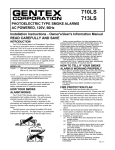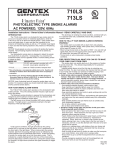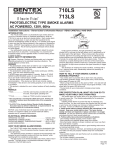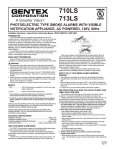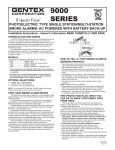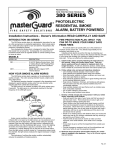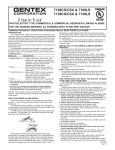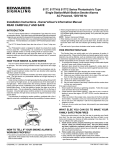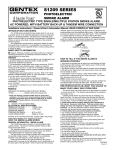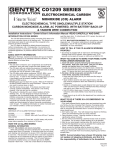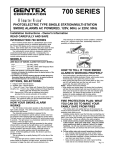Download Gentex-710LS 550-0060
Transcript
710LS 713LS PHOTOELECTRIC TYPE SMOKE ALARMS AC POWERED, 120V, 60Hz Installation Instructions - Owner's/User's Information Manual READ CAREFULLY AND SAVE INTRODUCTION The 713LS Smoke Alarm is a Photoelectric Type Smoke Alarm for use as an evacuation device in residential applications, while the 710LS is for use as an alert and relocate device. Each smoke alarm has a solid state piezo signal to warn and alert the household to the presence of threatening smoke. Your photoelectric smoke alarm is designed to detect the smoke that results from an actual fire. Consequently, it is uncommon for household smoke such as cigarette smoke or normal cooking smoke to cause an alarm. MODEL NO. DESCRIPTION 710LS* ...... 120 VAC Wall Mounted, Provided With a 9 ft. Line Cord, Pulsating Horn 713LS ...... Same as 710LS but with a Temporal Horn * This unit produces a non-temporal audible alarm and is therefore not intended for locations where the desired action of the occupant(s) is evacuation. NOTE: Loss of electrical input will cause the smoke alarm not to function. For maximum safety you should install both battery operated and AC powered smoke alarms. HOW YOUR SMOKE ALARM WORKS The 710LS/713LS Smoke Alarm operates on the photoelectric light scatter principle. The unit's sensing chamber houses a light source and a light sensor. The darkened sensing chamber is exposed to the atmosphere and designed to permit optimum smoke entry from any direction while rejecting light from outside the smoke alarm. The light source is an infrared (invisible) LED which pulses every 8 seconds. The light sensor is a photodiode matched to the light frequency of the LED light source. Under normal conditions, the light generated by the pulsing infrared LED is not seen by the light sensor, as it is positioned out of the direct path of the light beam. When smoke enters the sensing chamber, light from the pulsing LED light source is reflected by the smoke particles onto the photodiode light sensor. At the first sighting of smoke, the smoke alarm is put into a pre-alarm mode. This is indicated by a rapidly flashing LED on the face of the smoke alarm. Once the light sensor confirms smoke for 2 consecutive pulses inside the chamber, the light sensor produces the signal necessary to trigger the alarm. This technique of verifying the smoke condition, combined with a 5-to-1 signal-to-noise ratio, substantially reduces the possibility of nuisance alarms. HOW TO TELL IF YOUR SMOKE ALARM IS WORKING PROPERLY · Your smoke alarm is provided with an alarm horn and pulsating Light Emitting (indicator) Diode, which pulses every 15-30 seconds, and a green AC power on LED. · When turning the test knob on the alarm to TEST 1, the red LED will rapidly flash, the horn will sound and the strobe light will flash. If AC power fails, the green LED will turn off. · The test knob on your smoke alarm simulates actual smoke conditions. FIRE PROTECTION PLAN: WHAT YOU CAN DO TO MAKE YOUR FAMILY SAFE FROM FIRES This smoke alarm can quickly alert you to the presence of smoke-it cannot prevent fire. The ultimate responsibility for fire protection rests solely on you. Installing smoke alarms is just the first step in protecting your family from fires. You also must reduce the chances that fires will start in your home and increase your chances of safely escaping if one does start. To have an effective fire safety program: a. Install smoke alarms properly following the instructions in this manual. Keep your smoke alarms clean. Test your smoke alarm weekly and repair or replace it when it no longer functions. As with any electronic product, alarms have a limited life, and alarms that don't work cannot protect you. b. Follow safety rules and prevent hazardous situations: · Use smoking materials properly; never smoke in bed. · Keep matches and cigarette lighters away from children. · Store flammable materials in proper containers and never use them near open flames or sparks. · Keep electrical appliances and cords in good working order and do not overload electrical circuits. · Keep stoves, fireplaces, chimneys, and barbecue grills grease-free and make sure they are properly installed away from combustible materials. · Keep portable heaters and open flames such as candles away from combustible materials. · Do not allow rubbish to accumulate. · Do not leave small children home alone. c. Develop a family escape plan and practice it with your entire family, especially small children. · Draw a floor plan of your home and find two ways to exit from each room. There should be one way to get out of each bedroom without opening the door. Pg. 7-1 550-0060 · Teach children what the smoke alarm signal means, and that they must be prepared to leave the residence by themselves if necessary. Show them how to check to see if doors are hot before opening them, how to stay close to the floor and crawl if necessary, and how to use the alternate exit if the door is hot and should not be opened. · Decide on a meeting place a safe distance from your house and make sure that all your children understand that they should go and wait for you if there is a fire. · Hold fire drills at least every 6 months to make sure that everyone, even small children, know what to do to escape safely. · Know where to go to call the fire department from out side your residence. · Provide emergency equipment such as fire extinguishers and teach your family to use this equipment properly. d. Bedroom doors should be closed while sleeping if a smoke alarm is installed in the bedroom. They act as a barrier against heat and smoke. e. Establish an escape plan: · Post a detailed floor plan depicting the chosen escape routes. · Each bedroom should have at least two escape routes. · Make sure your children know what to do in case of fire and teach them to follow the escape plan you have posted. · Agree on an outside meeting place. · Conduct fire drills at least twice a year. · Be sure each member of the family is familiar with the smoke alarm so they can react properly. WHAT TO DO IF THERE IS A FIRE IN YOUR HOME If you have prepared family escape plans and practiced them with your family, you have increased their chances of escaping safely. Review the following rules with your children when you have fire drills so everyone will remember them in a real fire emergency. If smoke alarm should sound: a. Don't panic; stay calm. Your safe escape may depend on thinking clearly and remembering what you have practiced. b. Get out of the house following a planned escape route as quickly as possible. Do not stop to collect anything or to get dressed. c. Open doors carefully only after feeling to see if they are hot. Do not open a door if it is hot; use an alternate escape route. d. Stay close to the floor; smoke and hot gases rise. e. Cover your nose and mouth with a cloth, wet if possible, and take short, shallow breaths. f. Keep doors and windows closed unless you open them to escape. g. Meet at your prearranged meeting place after leaving the house. h. Call the Fire Department as soon as possible from outside your house. Give the address and your name. i. Never re-enter a burning building. Contact your local Fire Department for more information on making your home safer from fires and about preparing your family's escape plans. NOTE: Current studies have shown smoke alarms may not awaken all sleeping individuals, and that it is the responsibility of individuals in the household that are capable of assisting others to provide assistance to those who many not be awakened by the alarm sound, or to those who may be incapable of safely evacuating the area unassisted. WHAT THIS SMOKE ALARM CAN DO This smoke alarm is designed to sense smoke entering its sensing chamber. The smoke alarm does not sense gas, heat, or flames. When properly located, installed, and maintained, this smoke alarm is designed to provide early warning of developing fires at a reasonable cost. This smoke alarm monitors the air and, when it senses smoke, activates its built-in alarm horn. It can provide precious time for you and your family to escape from your residence before a fire spreads. Such an early warning, however, is possible only if the smoke alarm is located, installed, and maintained as specified in this User's Manual. NOTE: This smoke alarm is designed for use within single residential living units only; that is, it should be used inside a single-family home or one apartment of a multi-family building. In a multi-family building, the smoke alarm may not provide early warning for residents if it is placed outside of the residential units, such as on outside porches, in corridors, lobbies, basements, or in other apartments. In multi-family buildings, each residential unit should have alarms to alert the residents of that unit. Smoke alarms designed to be interconnected should be interconnected within one family residence only; otherwise, nuisance alarms will occur when an alarm in another living unit is tested. IMPORTANT NOTE: WHAT SMOKE ALARMS CANNOT DO Smoke alarms will not work without power. Batteryoperated smoke alarms will not work without batteries, with dead batteries, or if the batteries are not installed properly. AC powered smoke alarms will not work if their AC power supply is cut off by an electrical fire, an open fuse or circuit breaker, or for any other reason. If you are concerned about the reliability of either the batteries or your AC power supply for any of the above reasons, you should install both battery and AC powered alarms for maximum safety. Smoke alarms may not sense fire that starts where smoke cannot reach the alarms such as in chimneys, in walls, on roofs, or on the other side of closed doors. If bedroom doors are usually closed at night, smoke alarms should be placed in each bedroom as well as in the common hallway between them. Smoke alarms also may not sense a fire on another level of a residence or building. For example, a second-floor smoke alarm may not sense a first-floor or basement fire. Therefore, smoke alarms should be placed on every level of a residence or building. The horn in your smoke alarm meets or exceeds current audibility requirements of Underwriters Laboratories. However, if the smoke alarm is located outside a bedroom, it may not wake up a sound sleeper, especially if the bedroom door is closed or only partly open. If the smoke alarm is located on a different level of the residence than the bedroom, it is even less likely to wake up people sleeping in the bedroom. In such cases, the National Fire Protection Association recommends that the smoke alarms be interconnected so that an alarm on any level of the residence will sound an alarm loud enough to awaken sleepers in closed bedrooms. This can be done by installing a fire-detection system, by connecting alarms together, or by using radio frequency transmitters and receivers. All types of smoke alarm sensors have limitations. No type of smoke alarm can sense every kind of fire every time. In general, smoke alarms may not always warn you about fires caused by violent explosions, escaping gas, improper storage of flammable materials, or arson. NOTE: This smoke alarm is not designed to replace special-purpose fire detection and alarm systems necessary to protect persons and property in non-residential buildings such as warehouses, or other large industrial or commercial buildings. It alone is not a suitable substitute for complete fire-detection systems designed to protect individuals in hotels and motels, dormitories, hospitals, or other health and supervisory care and retirement institutions. Please refer to NFPA 101,The Life Safety Code, and NFPA 72 for smoke alarm requirements for fire protection in buildings not defined as "households." Installing smoke alarms may make you eligible for lower insurance rates, but smoke alarms are not a substitute for insurance. Home owners and renters should continue to insure their lives and property. PLACEMENT OF SMOKE ALARMS THIS EQUIPMENT SHOULD BE INSTALLED IN ACCORDANCE WITH THE NATIONAL FIRE PROTECTION ASSOCIATION'S STANDARD 72 (National Fire Protection Association, Batterymarch Park, Quincy, MA 02269). Pg. 7-2 550-0060 For your information, the National Fire Protection Association's Standard 72, reads as follows: "Smoke detectors shall be installed outside of each separate sleeping area in the immediate vicinity of the bedrooms and on each additional story of the family living unit including basements and excluding crawl spaces and unfinished attics. In new construction, a smoke detector shall be installed in each sleeping room." Where to Locate the Required Smoke Detectors in Existing Construction. The major threat from fire in a family living unit is at night when everyone is asleep. The principal threat to persons in sleeping areas comes from fires in the remainder of the unit; therefore, a smoke alarm(s) is best located between the bedroom areas and the rest of the unit. In units with only one bedroom area on one floor, the smoke alarms should be located as shown in Figure 1. Are More Smoke Detectors Desirable? The required number of smoke alarms may not provide reliable early warning protection for those areas separated by a door from the areas protected by the required smoke alarms. For this reason, it is recommended that the householder consider the use of additional smoke alarms for those areas for increased protection. The additional areas include: basement, bedrooms, dining room, near furnace room, utility room and hallways not protected by the required smoke alarms. The installation of smoke alarms in kitchens, attics (finished or unfinished), or garages is not normally recommended, as these locations occasionally experience conditions that can result in improper operation. IMPORTANT CONSIDERATION We recommend replacing your alarm(s) every ten (10) years; why: · Dust, dirt, and other environmental contaminants can affect your alarm over a prolonged period. · Fast changing industry consensus standards and codes on all alarms make it advisable to periodically upgrade your alarm to maximize life safety. Figure 1: A SMOKE ALARM SHOULD BE LOCATED BETWEEN THE SLEEPING AREA AND THE REST OF THE FAMILY LIVING UNIT. In family living units with more than one bedroom area or with bedrooms on more than one floor, more than one smoke alarm will be needed, as shown in Figure 2. · Assurance that your smoke alarm needs are kept abreast with the constantly improving electronic technology. · Smoke alarms are recognized as one of the lowest cost ways to protect dwelling inhabitants against the danger of fire(s). It makes good common sense to periodically replace and update your smoke alarm that contributes so much to life safety. MOUNTING LOCATION · Wall location-locate the top of the alarm at least 4 inches and not more than 12 inches from the ceiling. Observe alarm for proper top/bottom orientation (test knob is near bottom of unit). Figure 2: IN FAMILY LIVING UNITS WITH MORE THAN ONE SLEEPING AREA, A SMOKE ALARM SHOULD BE PROVIDED TO PROTECT EACH SLEEPING AREA (IN ADDITION, FIGURE 2 SHOWS REQUIRED ALARMS IN EACH BEDROOM FOR NEW CONSTRUCTION). In addition to smoke alarms outside of the sleeping areas, NFPA 72 requires the installation of a smoke alarm on each additional story of the family living unit, including the basement. These installations are shown in Figure 3. The living area smoke alarms should be installed in the living room or near the stairway to the upper level, or in both locations. The basement smoke alarm should be installed in close proximity to the stairway leading to the floor above. The alarm should be positioned relative to the stairway so as to intercept smoke coming from a fire in the basement before the smoke enters the stairway. Figure 3: A SMOKE ALARM SHOULD BE LOCATED ON EACH STORY. Where to Locate the Required Smoke Alarms in New Construction. All of the smoke alarms specified for existing construction are required, and, in addition, a smoke alarm is required in each bedroom. Figure 4: RECOMMENDED SMOKE ALARM MOUNTING LOCATION WHERE SMOKE ALARMS SHOULD BE PUT IN MOBILE HOMES In mobile homes built after about 1978 that were designed and insulated to be energy-efficient, smoke alarms should be installed as described in the section above. In older mobile homes that have little or no insulation compared to today's standards, uninsulated metal outside walls and roofs can transfer heat and cold from outdoors, making the air right next to them hotter or colder than the rest of the inside air. These layers of hotter or colder air can prevent smoke from reaching a smoke alarm. Therefore, put smoke alarms in such units only on inside walls, between 4 and 12 inches (10 and 30 cm) from the ceiling. If you are not sure about the insulation level in your mobile home, or if you notice that the walls or ceiling are unusually hot or cold, put the alarm on an inside wall. Minimum protection requires one alarm as close to the sleeping area as possible. For better protection, put one alarm in each room, but first read the "Locations to Avoid." Pg. 7-3 550-0060 LOCATIONS TO AVOID Nuisance alarms are caused by placing alarms where they will not operate properly. To avoid nuisance alarms, do not place alarms: · In or near areas where combustion particles are normally present such as kitchens; in garages where there are particles of combustion in vehicle exhausts; near furnaces, hot water heaters, or gas space heaters. Install smoke alarms at least 20 feet (6 meters) away from kitchens and other areas where combustion particles are normally present. · In air streams passing by kitchens. Figure 5 shows how a smoke alarm can be exposed to combustion particles in normal air movement paths, and how to correct this situation. Figure 6 Place the smoke alarm up to the mounting plate, rotating it to about 10:00 o'clock then rotate it clockwise to 12:00. It should "snap-lock" firmly into place. Keep the smoke alarm parallel to the mounting plate so upper and lower tabs on the plate seat into the smoke alarm. Figure 5 · In damp or very humid areas, or next to bathrooms with showers. The moisture in humid air can enter the sensing chamber as water vapor, then cool and condense into droplets that cause a nuisance alarm. Install smoke alarms at least 10 feet (3 meters) away from bathrooms. · In very cold or very hot environments, or in unheated buildings or outdoor rooms, where the temperature can go below or above the operating range of the alarm. Temperature limits for proper operation are 40° to 100°F (4.4° to 37.8°C). · In very dusty or dirty areas. Dust and dirt can build up on the smoke alarm's sensing chamber and can make it overly sensitive, or block openings to the sensing chamber and keep the smoke alarm from sensing smoke. · Near fresh air inlets or returns or excessively drafty areas. Air conditioners, heaters, fans, and fresh air intakes and returns can drive smoke away from smoke alarms, making the smoke alarms less effective. · In dead air spaces at the top of a peaked roof or in the corners between ceilings and walls. Dead air may prevent smoke from reaching the smoke alarm. · In insect-infested areas. If insects enter a smoke alarm's sensing chamber, they may cause a nuisance alarm. Get rid of the bugs before installing alarms where bugs are a problem. · Near fluorescent light fixtures. Electrical "noise" from nearby fluorescent light fixtures may cause a nuisance alarm. Install smoke alarms and fluorescent lights on separate electrical circuits. WARNING: Never disconnect an AC alarm to silence a nuisance alarm. Open a window or fan the air around the alarm to remove the smoke. The alarm will automatically turn off when the smoke in the air is completely gone. Do not stand close to the alarm. The sound produced by the alarm is loud because it is designed to awaken you in an emergency. Prolonged exposure to the horn at a close distance may be harmful to your hearing. MOUNTING: PLATE & ALARM LINE CORD MODEL 710LS/713LS The 710LS/713LS is supplied with a 9 foot line cord for installation to a normal outlet box. For this type of installation: 1. Care should be taken to lace cord through slots in base as show in in Figure 6 to insure cord does not interfere with engagement of the mounting bracket. 2. Determine proper location for smoke alarm above a receptacle that is NOT CONTROLLED BY AN "ON-OFF" SWITCH. 3. If screw anchors are used, drill two 3/16" holes, insert the screw anchors, and mount the plate to wall using the supplied screws. 4. Mount the smoke alarm as illustrated in Figure 7. 5. Use the enclosed cord retainer clamp as illustrated in Figure 6 to insure the unit is not accidentally disconnected. Figure 7 IMPORTANT WARNING: Failure to observe any of the conditions set forth may cause system malfunction and damage to the smoke alarm. CHECKOUT & TROUBLESHOOTING 1. Turn test knob to the NORMAL position and supply house power to the smoke alarm. The red indicator should flash every 30 seconds, showing that the smoke alarm is operating properly. 2. If red light is not flashing or the green LED is not on: a. Check the house current. b. Check to see if the plug is in the outlet. c. If the power and wiring check out, but the red light does not flash, return the alarm to the manufacturer. See TO RETURN A SMOKE ALARM. 3. Testing with the Test Knob: a. Rotate the test knob counter-clockwise to the TEST 1 position and wait up to 20 seconds for the smoke alarm to sound. If the smoke alarm does not sound after 20 seconds, return the smoke alarm for service. b. After successfully testing smoke alarm, return test knob to NORMAL (non-test) position and wait 20 seconds for the smoke alarm to stop sounding. c. To test smoke alarm for high sensitivity, turn test knob clockwise to test position 2. Smoke alarm should remain silent. Return knob back to the normal position. If your smoke alarm sounds during this test it means the smoke alarm's sensitivity has become too high and may cause false alarms. This could mean your smoke alarm is dirty and should be cleaned as described in the maintenance procedure below. If the smoke alarm continues to alarm for TEST 2 position following cleaning return it to Gentex for service. d. To check for proper smoke entry into your smoke alarm's sensing chamber. Gentex recommends using the Home Safeguard Smoke Detector spray. This test should be performed once a year and should be sprayed from a distance no closer than 12 inches from smoke alarm. Pg. 7-4 550-0060 IMPORTANT: The test knob is not an electrical switch, nor is it connected in any way to the alarm. Therefore, when you test with the test knob, you are actually simulating a smoke condition in the alarm, as well as testing the sensitivity of the photodiode and the circuit between the photodiode and the alarm. MAINTENANCE After your smoke alarm has been in operation for a period of time or if it was installed prior to the completion of all building construction, your smoke alarm may have become more sensitive due to dirt build-up in the smoke alarm's optic sensing chamber which could cause nuisance alarms or could cause activation from small amounts of smoke build-up. If this should occur, following this simple washing procedure will restore your smoke alarm back to its original condition. For further information, regarding frequency of cleaning and testing, refer to NFPA 72, NFPA, Batterymarch Park, Quincy, MA 02269. IMPORTANT: Failure to follow full cleaning instructions could result in damage to this smoke alarm. DO NOT remove all alarms at the same time for cleaning. 1. Unplug the electrical power cord to the smoke alarm. 2. Twist the smoke alarm counter-clockwise to remove it from its mounting plate. 3. Select three (3) standard size wash buckets and fill them each with one gallon of normal tap water (distilled or de-ionized treated water is recommended as a final rinse if water is extremely hard in your area). 4. Add 1/8 cup of Ivory dishwashing liquid to the first bucket of water and allow it to mix thoroughly, then place one dirty smoke alarm into the soap water mixture until it becomes completely covered or submerged. NOTE: If the smoke alarms are exceptionally dirty, you may wish to first wipe off any excess dirt before washing smoke alarm so as not to dirty the wash water too quickly. DO NOT open smoke alarm for cleaning. IF SMOKE ALARM IS OPENED DURING CLEANING, PRODUCT WARRANTY BECOMES VOID. WARNING: ONLY IVORY DISHWASHING LIQUID IS TO BE USED. OTHER BRANDS ARE NOT RECOMMENDED AND MAY CAUSE YOUR SMOKE ALARM TO MALFUNCTION. 5. 6. Allow smoke alarm to soak for approximately 10 minutes (longer if extremely dirty). Then agitate for 5 or 10 seconds to flush out any remaining dirt left inside smoke alarm's housing. Remove smoke alarm from wash water and transfer directly to one of the first rinse buckets containing clear water. Again, allow smoke alarm to become completely submerged, agitate once more for 5 or 10 seconds to remove soap residue. 7. Finally, transfer smoke alarm to your second and final rinse bucket, repeating method found in Step 6, then remove smoke alarm to a clean dry area for a period of 48 hours to allow it to thoroughly dry. WARNING: SMOKE ALARMS ARE TO BE AIR DRIED ONLY. DO NOT PLACE SMOKE ALARM IN OVEN, MICROWAVE OR USE A HOT AIR BLOWER TO ACCELERATE DRYING TIME. THIS COULD RESULT IN DAMAGE TO YOUR SMOKE ALARM. IMPORTANT: IT IS RECOMMENDED TO CHANGE WASH AND RINSE WATER AFTER FIVE (5) SMOKE ALARMS. IF YOUR SMOKE ALARMS ARE EXTREMELY DIRTY, WATER SHOULD BE CHANGED MORE FREQUENTLY. In the event you experience difficulty in the cleaning of your smoke alarm or if you have any questions, please contact Gentex Corporation or your local Gentex distributor. WARNING If the smoke alarm does not work properly, do not try and fix it yourself. This will void your warranty. See "To Return A Smoke Alarm" for instructions to return smoke alarms that do not operate properly. DO NOT TRY TO FIX IT YOURSELF. IMPORTANT: Gentex recommends smoke alarms be tested a minimum of once a week. WARNING: Never use an open flame of any kind to test your smoke alarm. You may ignite and damage the smoke alarm as well as your home. The test feature of your smoke alarm accurately simulates smoke conditions and tests the smoke alarm's functions as required by Underwriters Laboratories. WARNING: Do not cover, tape, or otherwise block the openings of your smoke alarm. These openings are designed to allow air to pass through your smoke alarm, thus sampling the air around the alarm. WARNING: Smoke alarms are not to be used with detector guards unless the combination has been evaluated and found suitable for that purpose. FAILURE TO REGULARLY CLEAN THIS SMOKE ALARM WILL RESULT IN FALSE ALARMS. A BUILD UP OF DUST CREATES AN OBSCURATION THAT SIMULATES SMOKE. THIS MEANS THE UNIT WILL GO INTO ALARM WITHOUT A FIRE CONDITION. TO RETURN A SMOKE ALARM Should you experience problems with your smoke alarm, proceed as follows: 1. Unplug the electrical power cord to the smoke alarm. 2. Twist the smoke alarm counter-clockwise to remove it from its mounting plate. 3. Carefully pack (the manufacturer cannot be responsible for consequential damage) and return to the manufacturer. Include complete details as to exact nature of difficulties being experienced and date of installation. 4. Return to: Gentex Corporation, 10985 Chicago Drive, Zeeland, Michigan 49464. Prior to returning, call Gentex at 1-800-436-8391 or e-mail [email protected] to obtain a RMA Number from our return department. LIMITED WARRANTY For a period of 12 months from the date of purchase, or a maximum of 18 months from the date of manufacture, Gentex warrants to you, the original consumer purchaser, that your Smoke Alarm will be free from defects in workmanship, materials, and construction under normal use and service. If a defect in workmanship, materials, or construction should cause your Smoke Alarm to become inoperable within the warranty period, Gentex will repair your Smoke Alarm or furnish you with a new or rebuilt replacement Smoke Alarm without charge to you except for postage required to return the Smoke Alarm to us. Your repaired or replacement Smoke Alarm will be returned to you free of charge and it will be covered under this warranty for the balance of the warranty period. This warranty is void if our inspection of your Smoke Alarm shows that the damage or failure was caused by abuse, misuse, abnormal usage, faulty installation, improper maintenance, or repairs other than those performed by us. ANY WARRANTIES IMPLIED UNDER ANY STATE LAW, INCLUDING IMPLIED WARRANTIES OF MERCHANTABILITY OR FITNESS FOR A PARTICULAR PURPOSE, APPLY ONLY FOR THE WARRANTY PERIOD SPECIFIED ABOVE. PLEASE NOTE THAT SOME STATES DO NOT ALLOW LIMITATIONS ON HOW LONG AN IMPLIED WARRANTY LASTS, SO THE ABOVE EXCLUSION MAY NOT APPLY TO YOU. GENTEX WILL NOT BE LIABLE FOR ANY LOSS, DAMAGE, INCIDENTAL OR CONSEQUENTIAL DAMAGES OF ANY KIND ARISING IN CONNECTION WITH THE SALE, USE, OR REPAIR OF THIS SMOKE ALARM. PLEASE NOTE THAT SOME STATES DO NOT ALLOW THE EXCLUSION OR LIMITATION OF INCIDENTAL OR CONSEQUENTIAL DAMAGES. SO THE ABOVE EXCLUSION MAY NOT APPLY TO YOU. If a defect in workmanship, materials, or construction should cause your Smoke Alarm to become inoperable within the warranty period, you must return the Smoke Alarm to Gentex postage prepaid. You must also pack the Smoke Alarm to minimize the risk of it being damaged in transit. You must also enclose a return address. Smoke Alarms returned for warranty service should be sent to: Gentex Corporation, 10985 Chicago Drive, Zeeland, MI 49464. If we receive a Smoke Alarm in a damaged condition as the result of shipping, we will notify you and you must file a claim with the Shipper. THIS LIMITED WARRANTY GIVES YOU SPECIFIC LEGAL RIGHTS. YOU MAY ALSO HAVE OTHER RIGHTS WHICH VARY FROM STATE TO STATE. Important Notice: These materials have been prepared by Gentex Corporation ("Gentex") for informational purposes only, are necessarily summary, and are not purported to serve as legal advice and should not be used as such. Gentex makes no representations and warranties, express or implied, that these materials are complete and accurate, up-to-date, or in compliance with all relevant local, state and federal laws, regulations and rules. The materials do not address all legal considerations as there is inevitable uncertainty regarding interpretation of laws, regulations and rules and the application of such laws, regulations and rules to particular fact patterns. Each person's activities can differently affect the obligations that exist under applicable laws, regulations or rules. Therefore, these materials should be used only for informational purposes and should not be used as a substitute for seeking professional legal advice. Gentex will not be responsible for any action or failure to act in reliance upon the information contained in this material. 550-0060-13 GENTEX CORPORATION 10985 CHICAGO DRIVE, ZEELAND, MI 49464 PHONE: 1-800-436-8391 www.gentex.com [email protected] 9-1-87 Pg. 7-5





